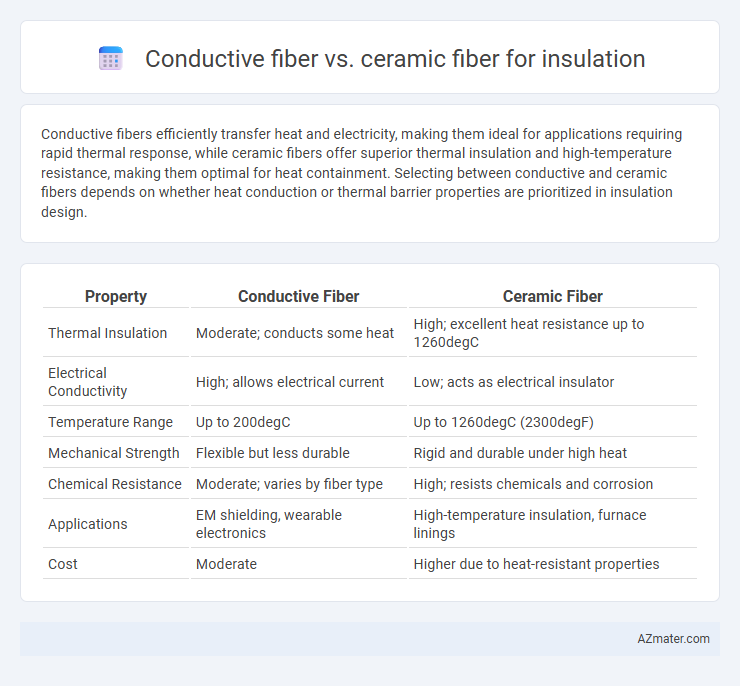Conductive fibers efficiently transfer heat and electricity, making them ideal for applications requiring rapid thermal response, while ceramic fibers offer superior thermal insulation and high-temperature resistance, making them optimal for heat containment. Selecting between conductive and ceramic fibers depends on whether heat conduction or thermal barrier properties are prioritized in insulation design.
Table of Comparison
| Property | Conductive Fiber | Ceramic Fiber |
|---|---|---|
| Thermal Insulation | Moderate; conducts some heat | High; excellent heat resistance up to 1260degC |
| Electrical Conductivity | High; allows electrical current | Low; acts as electrical insulator |
| Temperature Range | Up to 200degC | Up to 1260degC (2300degF) |
| Mechanical Strength | Flexible but less durable | Rigid and durable under high heat |
| Chemical Resistance | Moderate; varies by fiber type | High; resists chemicals and corrosion |
| Applications | EM shielding, wearable electronics | High-temperature insulation, furnace linings |
| Cost | Moderate | Higher due to heat-resistant properties |
Introduction to Insulation Materials
Conductive fibers, typically made from metal or carbon-based materials, are designed to facilitate heat transfer and electrical conductivity, making them suitable for applications requiring efficient thermal or electrical conduction. Ceramic fibers consist of alumina, silica, or other metal oxides, offering excellent thermal insulation, high-temperature resistance, and chemical stability, ideal for fireproofing and heat shielding in industrial settings. Both materials serve critical roles in insulation, with conductive fibers enhancing heat dissipation and ceramic fibers maximizing thermal resistance.
Overview of Conductive Fiber
Conductive fiber is engineered with high electrical and thermal conductivity, making it ideal for applications requiring efficient heat dissipation and electromagnetic shielding. Unlike ceramic fiber, which excels in thermal insulation due to its low thermal conductivity, conductive fiber integrates metallic elements or conductive polymers to enhance performance in electronic and industrial environments. This fiber type supports better temperature regulation and electrical grounding, critical in advanced insulation systems.
Overview of Ceramic Fiber
Ceramic fiber insulation offers exceptional thermal resistance, withstanding temperatures up to 2300degF (1260degC), making it ideal for high-temperature industrial applications. Its low thermal conductivity, typically around 0.2 W/m*K, ensures efficient heat retention and energy savings. Unlike conductive fibers that may transfer heat, ceramic fibers provide superior thermal barrier properties and chemical stability, enhancing durability in harsh environments.
Key Properties of Conductive Fiber
Conductive fibers are characterized by their excellent electrical and thermal conductivity, making them ideal for applications requiring efficient heat dissipation and electrical signal transmission. Unlike ceramic fibers, which excel in thermal insulation due to low thermal conductivity and high heat resistance, conductive fibers offer flexibility, lightweight properties, and durability under mechanical stress. Their inherent conductivity and resilience make them suitable for advanced insulation solutions in electronics, wearable technology, and electromagnetic shielding.
Key Properties of Ceramic Fiber
Ceramic fiber insulation exhibits exceptional thermal resistance, typically withstanding temperatures up to 2300degF (1260degC), making it ideal for high-temperature applications unlike conductive fibers that often have lower heat tolerance. Its low thermal conductivity, usually around 0.13 W/m*K at 1000degC, ensures efficient heat retention and energy savings. Additionally, ceramic fiber offers excellent chemical stability and corrosion resistance, enhancing durability in harsh industrial environments.
Thermal Insulation Performance Comparison
Ceramic fiber insulation exhibits superior thermal resistance with operating temperatures typically ranging from 1000degC to 1400degC, outperforming conductive fibers that generally withstand up to 600degC. The low thermal conductivity of ceramic fibers, often below 0.12 W/m*K, provides enhanced heat retention and energy efficiency compared to conductive fibers, which have higher thermal conductivity due to their metal content. Ceramic fibers also maintain structural integrity at elevated temperatures, making them optimal for high-temperature industrial applications where thermal insulation performance is critical.
Electrical Conductivity Differences
Conductive fibers, often made of metal-coated or carbon-based materials, exhibit high electrical conductivity, making them suitable for applications requiring efficient electrical current flow and electromagnetic interference shielding. Ceramic fibers, composed primarily of alumina and silica, are excellent electrical insulators with very low conductivity, ideal for thermal insulation without conducting electricity. The key difference lies in their electron mobility: conductive fibers facilitate electron flow, whereas ceramic fibers restrict it, ensuring electrical isolation in high-temperature environments.
Durability and Longevity Factors
Conductive fibers offer enhanced durability due to their higher resistance to thermal cycling and mechanical stress, making them suitable for long-term insulation applications in high-temperature environments. Ceramic fibers excel in longevity by providing excellent thermal stability and chemical resistance, maintaining structural integrity even after prolonged exposure to extreme heat. Choosing between conductive and ceramic fibers depends on the specific durability requirements and operational conditions, with ceramic fibers typically preferred for environments demanding superior thermal insulation over extended periods.
Applications and Use Cases
Conductive fibers excel in applications requiring efficient electrical or thermal conductivity, such as electromagnetic shielding, flexible heaters, and wearable electronics insulation. Ceramic fibers are preferred for high-temperature insulation in industrial furnaces, kilns, and thermal barriers due to their excellent heat resistance and low thermal conductivity. Use cases of conductive fibers include smart textiles and sensors, while ceramic fibers are dominant in sectors demanding extreme heat insulation like aerospace and metallurgy.
Selecting the Right Fiber for Your Needs
Conductive fiber offers superior thermal efficiency and durability, making it ideal for applications requiring rapid heat transfer and high electrical conductivity, such as in aerospace or electronic insulation. Ceramic fiber excels in high-temperature resistance and excellent thermal insulation, suitable for furnace linings, kilns, and heat shields where maximum heat containment is essential. Selecting the right fiber depends on balancing thermal conductivity needs, temperature tolerance, and the specific environmental conditions of the application.

Infographic: Conductive fiber vs Ceramic fiber for Insulation
 azmater.com
azmater.com